|
Chequers Hill/The Street
Doddington
01795 886 366
https://www.chequersinndoddington.co.uk/
https://whatpub.com/chequers
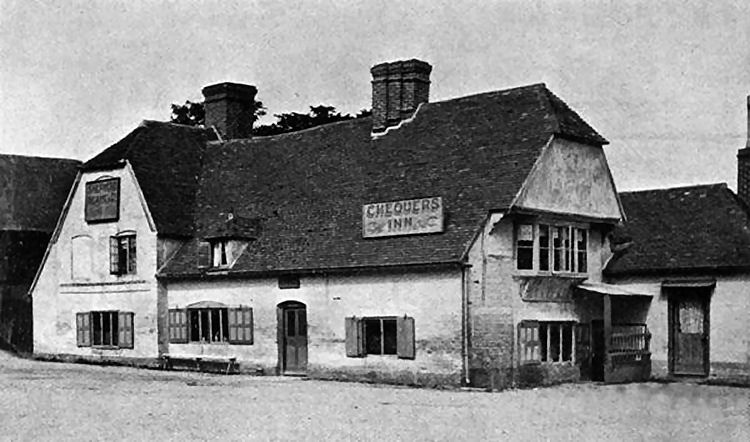
Above photo taken from "Old Country Inns of England," date unknown. |

Above photo, date unknown. |

Above postcard, circa 1907, then as now, in the livery of Shepherd Neame's Faversham Brewery. Kindly sent by Rory Kehoe. |
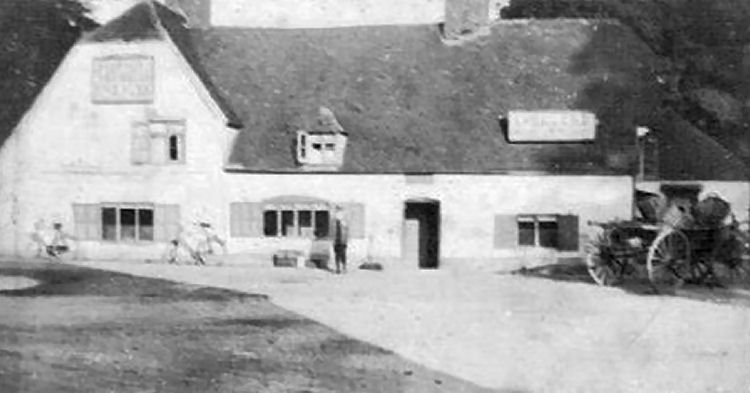
Above photo, circa 1910, kindly sent by Rory Kehoe. |
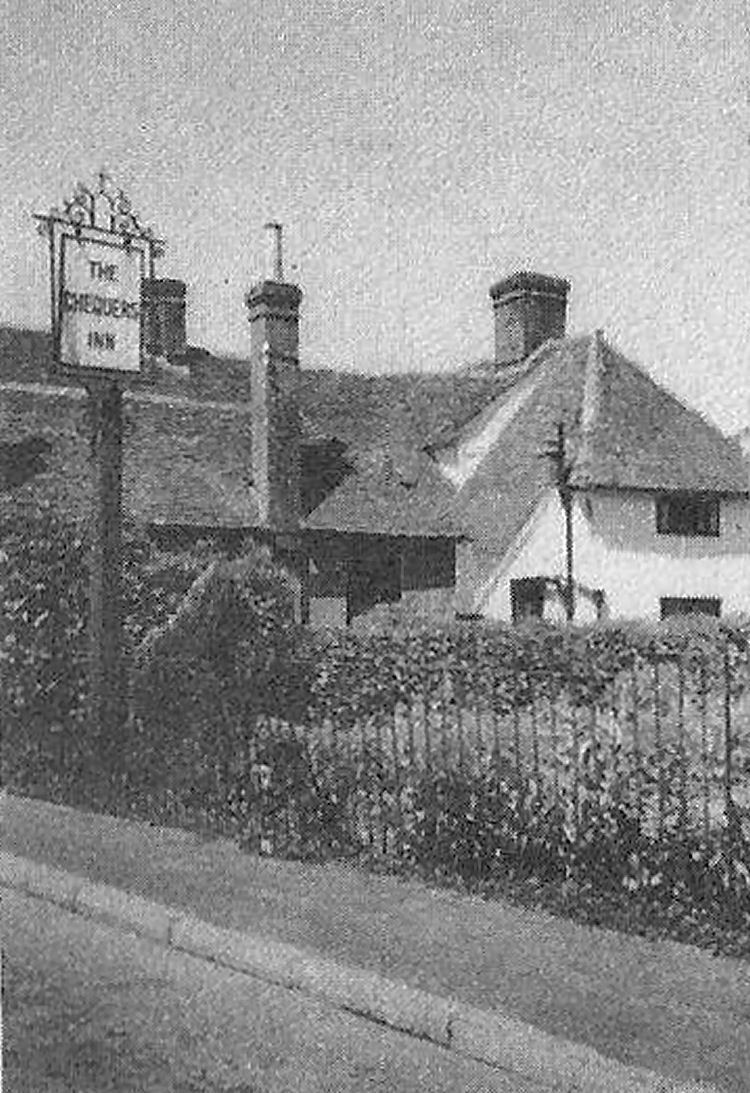
Above photo, date unknown. |
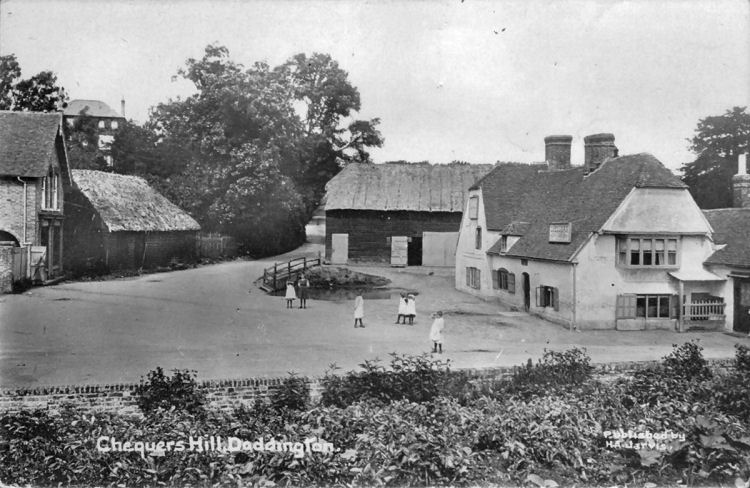
Above postcard, date unknown. |
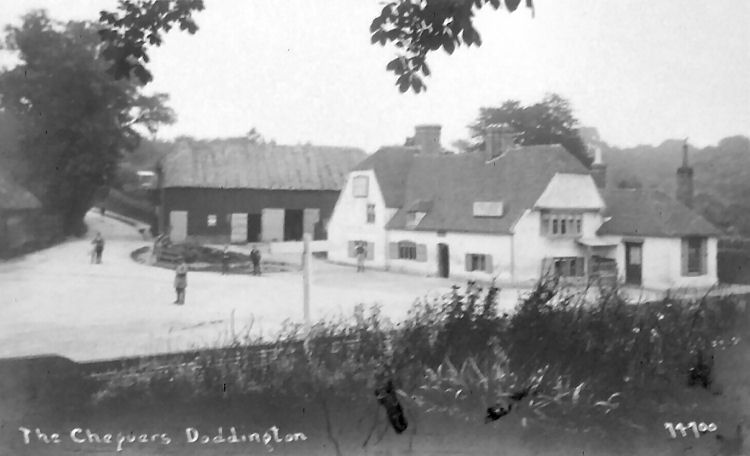
Above postcard, circa 1920, kindly sent by Rory Kehoe. |
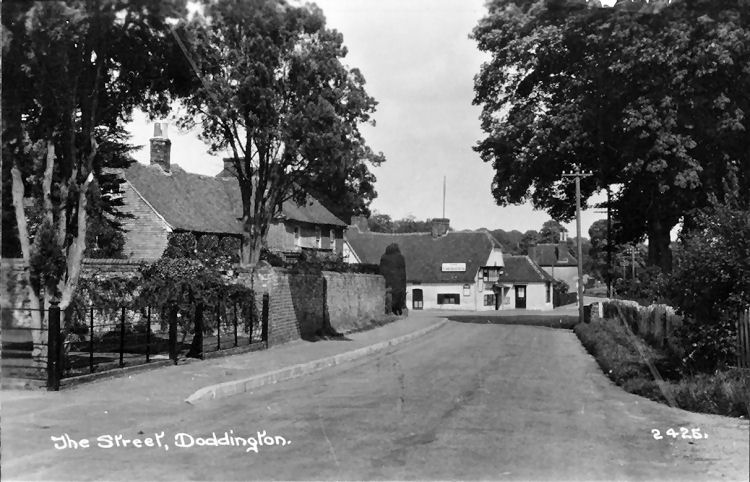
Above postcard, date unknown. |
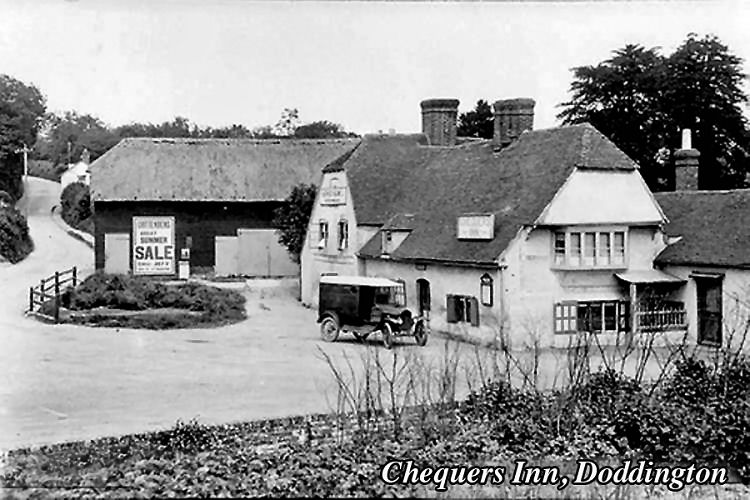
Above postcard, 1940, kindly supplied by John Robertson. |
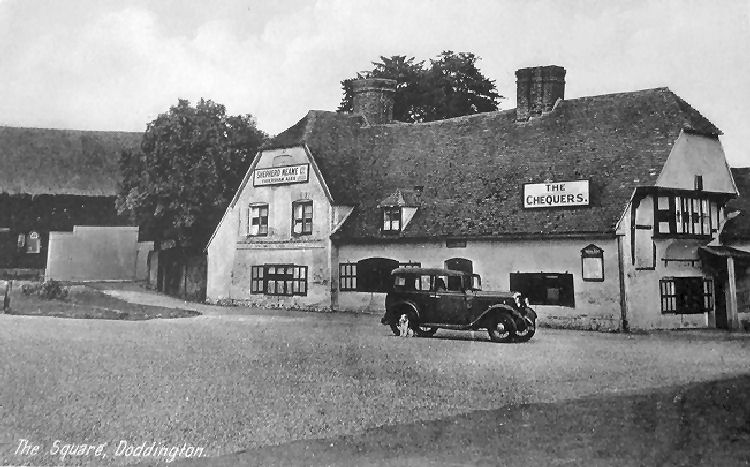
Above photo, circa 1940, kindly supplied by Rory Kehoe. |
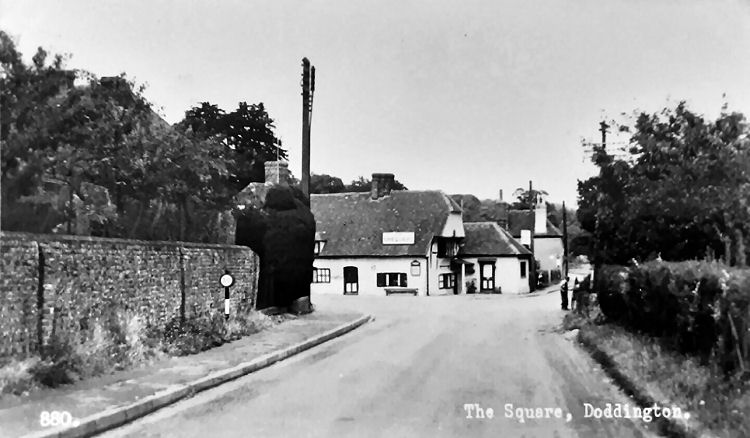
Above postcard, circa 1949, kindly sent by Rory Kehoe. |
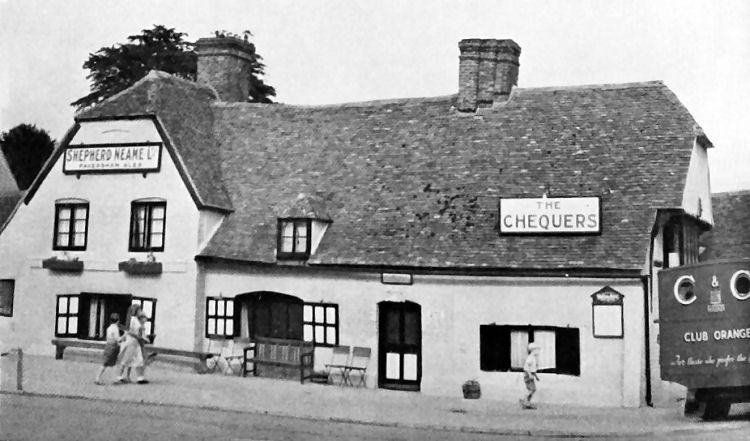
Above postcard, circa 1954, kindly sent by Rory Kehoe. |

Above photo showing the barn, late 1950s. |

Above photo showing the barn, late 1950s. |

Above photo showing the barn, late 1950s. |

Above photo showing the barn, late 1950s. |

Above photo, date unknown, by kind permission of Eric Hartland. |

In the 1980s the barn next to the "Chequers" burnt down.
Picture by Liz Sewell. |

In the 1980s the barn next to the "Chequers" burnt down.
Picture by Liz Sewell. |
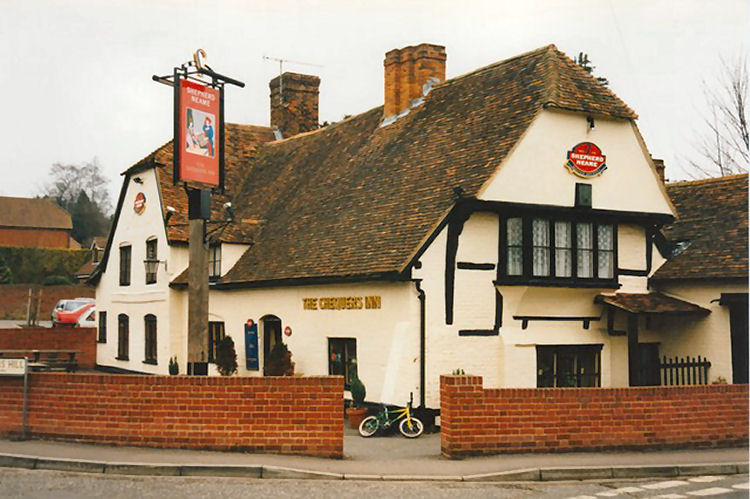
Above photo, February 1996, kindly sent by Philip Dymott. |
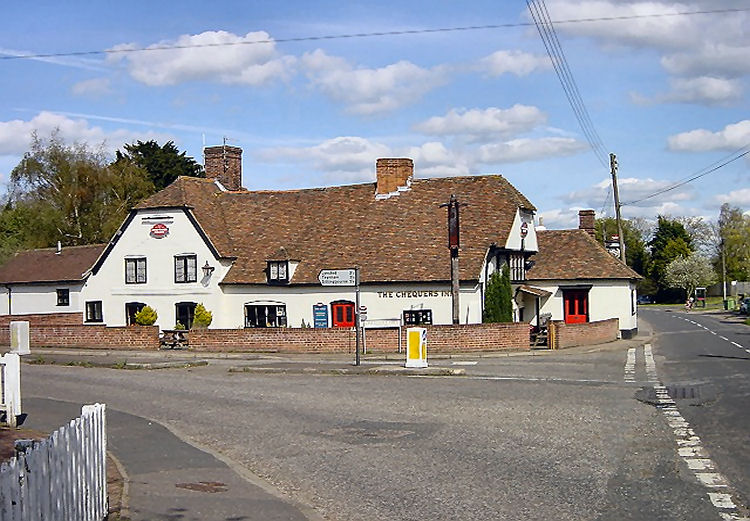
Photo by Penny Mays 2005 from
http://www.flickr.com. |
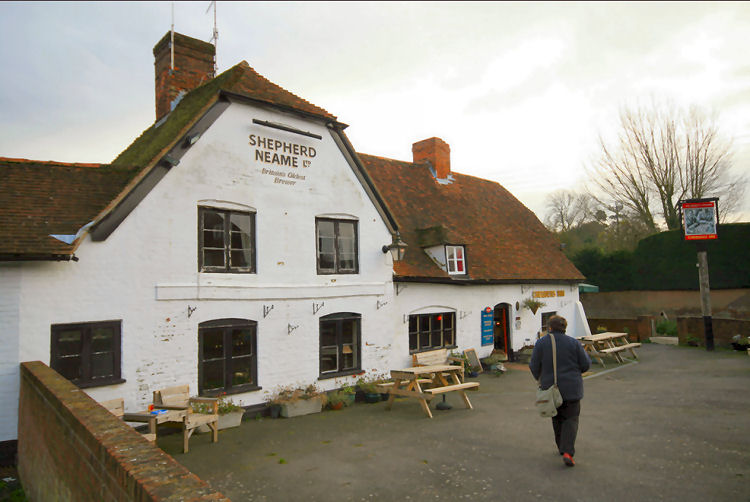 Photo taken 1 December 2012 from
http://www.flickr.com
by Jelltex. |
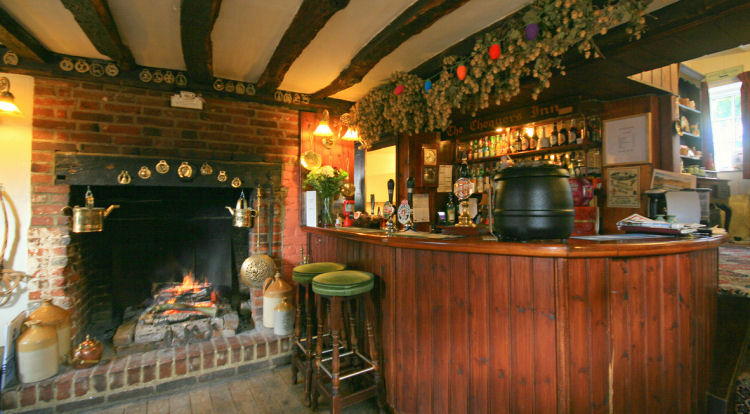
Photo taken 1 December 2012 from
http://www.flickr.com
by Jelltex. |
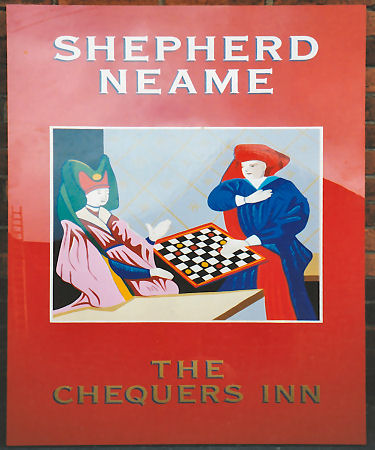 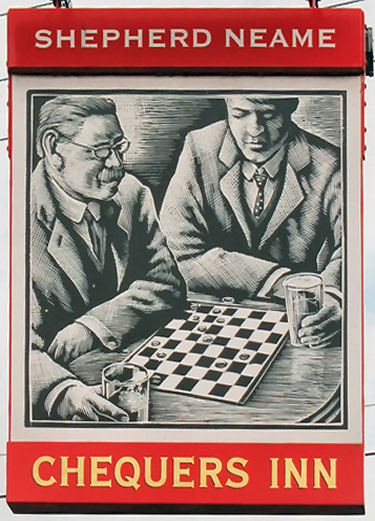 Above sign
left, September 1993, sign right, 2011.
With thanks from Brian Curtis
www.innsignsociety.com.
|
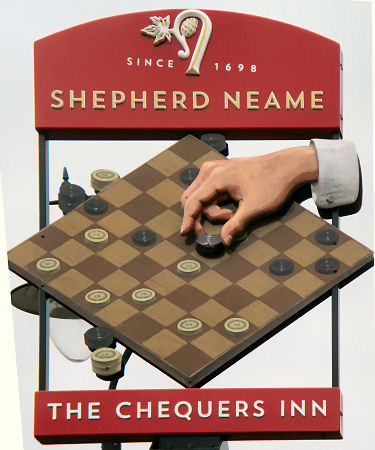
Above sign, 2020, kindly taken and sent by Roger Pester. |
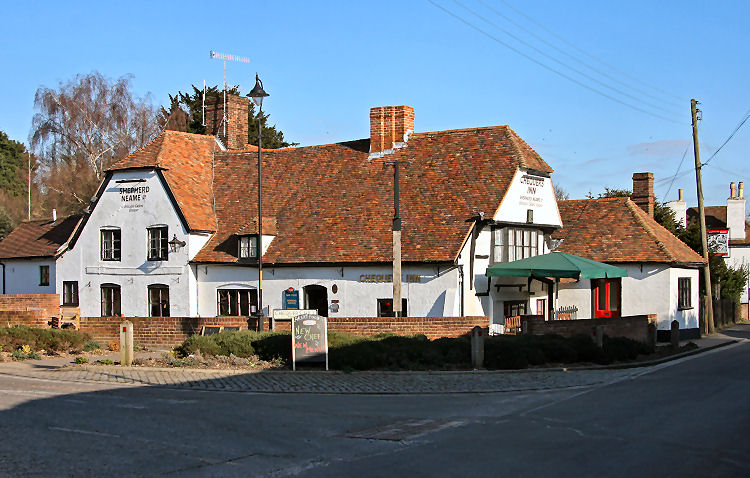
Above photos, 3 February 2012, taken by Eric Hartland. |
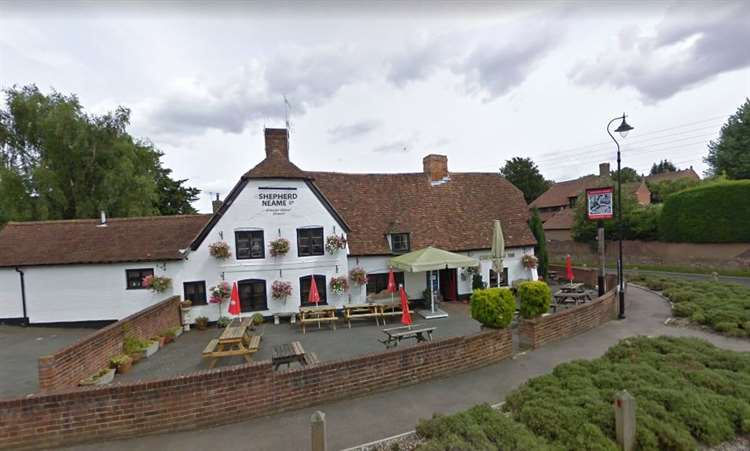
Above photo 2019. |
The "Chequers Inn" is on a main road at Doddington, a fifteenth
century coaching inn along the old way from Maidstone to Faversham. Nowadays
the main local highway is the M2 motorway, not far from the village.
It is reported to have two resident ghosts - a Cavalier from the English
Civil War, it’s rumoured that you can spot him wearing a plumed hat from the
overhanging window, and, if you listen carefully, a ghoul with a passion for
the piano, reported to be the deceased wife of a past Landlord.
|
From the Kentish Gazette, 16 March 1810.
DEATH.
March 10, at Doddington, after a long and painful illness, sustained
with much fortitude, Lean, daughter of John and Dene Palmer, of the
"Chequers Inn," at that place, aged 11 years.
|
|
From the Kentish Chronicle, 6 June, 1863.
A MAN BURIED ALIVE IN A CHALK PIT.
On Saturday, Mr. W. P. Callaway, deputy coroner, and a respectable jury
held an inquest at the “Chequers Inn,” Doddington, on the body of Edward
Foster, labourer, aged 20 years, who was killed by a full of earth in a
chalk pit on Friday morning.
The first witness called was Ann Wildish, widow, of Doddington Hill, who
deposed:- Yesterday morning about half past six I was in doors and heard
some one approaching. My house is close to the entrance of the chalk pit
in which the deceased was found. I looked out of the window and saw the
deceased. He was then going to his work in the pit. He had none of his
tools with him then.
Frances, wife of Mr. Jesse Higgins, of Doddington, deposed:- I reside
within a short distance of the pit, and my husband is master of the lime
works. About half-seven yesterday morning two carts came for lime, and
my husband not being then in the way, I went down into the pit to see if
I could find deceased; but I could not see him. I could not find his
shovel, but I saw that the bank had fallen in, and I could see a portion
of a wheelbarrow, the remainder being buried. I went for assistance to
the men with the lime carts, and they commenced digging for the
deceased. I was present when the body was found. The bank was not
hanging over when I saw it previous to the accident.
David Millens, bailiff, of Down Court, Doddington, deposed:- Yesterday
morning, about seven o'clock, I went to Mr. Kemmin's pit for lime. I
could find no one there until the last witness came. I enquired for
deceased and the last witness said he could not be far off, and she went
down to the pit, to find him, and came back to me saying she was afraid
he was buried as there had been a fall of chalk. I went to the pit and
saw there had been a fall, and a portion of a wheelbarrow was visible. I
commenced digging and continued doing so for about three-quarters of an
hour when I came to the body of deceased. He was lying on his face quite
flat. The body was a very short distance from the wheelbarrow. The
deceased was quite dead when we found him. I assisted to remove the
body.
Walter Kemmins, lime merchant, of Greenstreet, deposed:- The pit in
which the deceased was found belonged to me. I have worked it for about
two years. The deceased has worked for me off and on for four or five
months. I have worked the pit for the last twelve months continually,
and have been in the habit of constantly seeing it. I was at the pit
last Monday. The deceased was then working there alone. He was working
there alone until the morning of his death. I last saw the deceased
alive on Thursday night. He was then at Highsted, working in another pit
for me. On Monday last, when I went to the pit, he was pecking chalk
from the bottom of the bank. I stopped him and gave him special orders
not to touch the bottom any more, until he had thrown in a peak which
was then hanging over. The reason why I told him so was that I
considered the place unsafe. I am certain the deceased did not follow my
instructions or I should be able to see the marks of the pick which he
must have used in throwing in the top.
Henry Adam M.D. and M.R.C.S., of Greenstreet, deposed:- I was sent for
yesterday morning to the chalk pit, and on arriving found the body of
deceased lying in the lime house. I examined him and from the injuries I
found I am positive death was instantaneous. I am also positive the
deceased was stooping at the time of the accident as the spine in
fractured in two places. There was also fracture of the pelvis, and both
bones of the left leg and left foot were broken. Most probably the skull
would have been injured if the deceased had been standing. The cause of
instantaneous death was dislocation of the vertebrae of the neck.
The deputy coroner having summed up, the jury returned a verdict that
the deceased was accidentally killed by the falling of a bank of chalk.
|
|
From the Kentish Gazette, 25 July 1865.
DODDINGTON. Fatal Accident.
Mr. Coroner Delasaux held an inquest at the "Chequer’s Inn,"
Doddington, on Friday, on the body of an aged woman named Jane
Everist Johnson, who was killed on the previous Tuesday, by falling
from a tree in an orchard, at Shulland Farm, while engaged in
gathering cherries. The deceased was subject to fits, and Mr.
Craigie, surgeon, expressed his opinion that the accident probably
happened from that cause. The jury returned a verdict of "Accidental
death."
|
|
From The Dover Express, Saturday, July 29, 1865; pg. 4; Issue 365.
COUNTY EPITOME.
Mr. Coroner Delasaux held an inquest at the "Chequers Inn," Doddington,
on Friday, on the body of an aged woman named Jane Everist Johnson, who
was killed on the previous Tuesday by falling from a tree in an orchard,
at Shulland Farm, while engaged in gathering cherries. The deceased was
subject to fits, and Mr. Cragie, surgeon, expressed his opinion that the
accident probably happened from that cause.
The jury returned a verdict
of "Accidental death."
|
|
Abergavenny Chronicle, Friday 29 January 1897.
Four Years For Arson.
Albert Terry, publican, at Doddington, Kent, was charged at Maidstone
assizes, before Mr. Justice Matthew, with feloniously setting fire to a
windmill of his own at Lenham on December 23rd last with intent to
defraud.
Mr. C. Gill and Mr. A. Gill appeared for the prosecution; Mr. Dickens,
Q.C., and Mr. Hobler for the defence.
The prosecution alleged that in February, 1896, the prisoner, the owner
of a mill some four miles from his home, went to the then tenants of the
mill, who was in pecuniary difficulties, and proposed to him to set fire
to the mill, taking with him a tin of pitch and two sacks of shavings.
The tenant refused, and subsequently gave information to the police, who
kept watch on the mill. The tenant stated that he burnt the shavings and
through the tin down the well 45 ft. deep. The tenant subsequently was
sold up and left, owing rent. The mill then remained empty.
On December 21st it was stated that the prisoner brought a sack of
shavings and half a gallon of harness oil.
On the 23rd he was away from home in his high dog-cart several hours in
the afternoon. That evening, about 7:30 a policeman noticed the marks of
wheels in the snow on the drive leading up to the mill. A little
previously a witness had noticed the high dog-cart with two men in it
drive up there.
At 10:20 p.m. the mill was on fire at the top and was soon burnt down.
The policeman then measured the width from wheel track to wheel track.
It corresponded, it was stated, with the width of the wheels of the
prisoners cart.
For the defence, witnesses were called to prove an alibi and to show
that the wheel tracks could not be those of the prisoners cart.
Mr. Dickens urged that no motive for the crime, such as over-insurance,
had been suggested.
The jury found the prisoner Guilty, and he was sentenced to penal
servitude for 4 years.
|
|
Faversham Times and Mercury and North-East Kent Journal 06 May 1939.
DODDINGTON. THE CHEQUERS.
At the Faversham County Petty Sessions, yesterday (Thursday), the Bench
approved of a plan presented by Messrs. Shepherd Neame Ltd. for
alterations and additions to the "Chequers," Doddington.
|
|
From the
https://www.kentonline.co.uk By Ed McConnell, 28 October 2019.
Haunted pubs in Kent this Halloween.
Kent's colourful history and strong ties to smuggling mean it has its
fair share of ghost stories.
This 12th century boozer also has a rich history and strong ties to
smuggling. It is haunted by two ghosts. One is a Civil War cavalier
killed upstairs and his plumed-hatted form is often seen peering through
a window and laughing. The second is thought to be the wife of a former
landlord. She can be heard playing the piano in the private quarters.
|
|
From the
https://www.kentlive.news By Lauren MacDougall, 21 December 2019.
The 33 pubs in Kent you have to drink at in 2020 according to CAMRA.
In total Kent has heaps of pubs listed in the guide and, while 33 of
these are new entries, others have appeared in previous editions of the
guide.
A total of 33 pubs from around Kent make up the new entries that feature
in the 2020 edition of the Good Beer Guide.
The guide is produced annually by the Campaign for Real Ale (CAMRA), the
independent guide to the best boozers in the UK that is researched by
unpaid and independent volunteers nationwide.
Tom Stainer, CAMRA’s chief executive, said: “For nearly five decades,
the Good Beer Guide has been a comprehensive guide to the UK’s
breweries, their ales, and the best outlets to find them in across the
country.
“What makes the Guide unique is that all the entries are compiled and
vetted by a huge volunteer team, based around the country. We work hard
to ensure that all areas of the country are covered and, unlike with
some competitor titles, inclusion in this book is dependent only on
merit, not on payment.
“The Good Beer Guide has always had an important role in acting as a
barometer of the beer and pub industry. We believe information gleaned
from the Guide is absolutely vital in the drive to save our pubs from
closure and campaign for policies that better support pubs, local
brewers and their customers.”
This pub is included in the 2020 list.
Chequers Inn, Doddington.
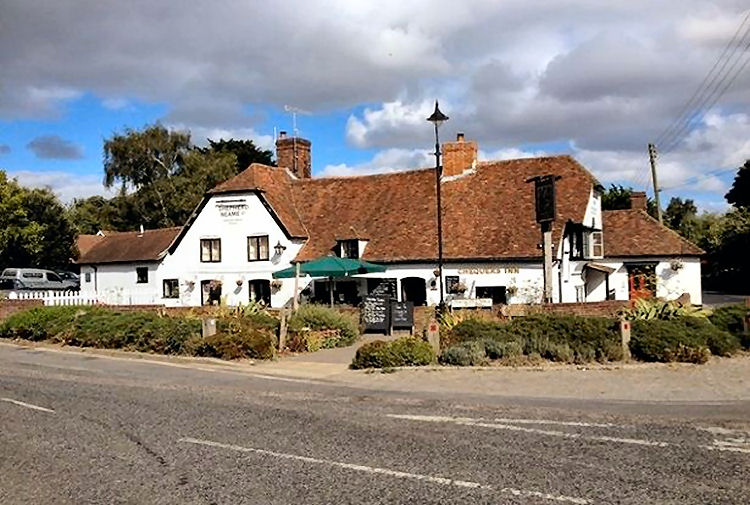
What the guide says: "Attractive oak-beamed pub dating from the 15th
century.
"It is the heart of village life, with a variety of events held,
including a beer festival at the end of April. A roaring log fire keeps
customers warm in winter, and the pub frontage is a sea of flowers in
summer." |
LICENSEE LIST
PALMER John 1810+
PALMER Ann 1841+ (age 60 in 1841 ) )
PALMER John (James) Henry 1851-July/64 (age 43 in 1861 ) )

SAGE Alfred July/1864-91+ (age 46 in 1881 ) )

TERRY Martha Ann to Sept/1897

MOORE John Sept/1897+

EASTON Alfred J 1901-03+ (age 42 in 1901 ) )

SARGENT George 1911-38+ (age 41 in 1911 ) )
???? Gayna & Shaun 2015+
https://pubwiki.co.uk/Chequers.shtml
 From the Kelly's Directory 1903 From the Kelly's Directory 1903
 Census Census
 Kentish Gazette Kentish Gazette
 Whitstable Times
and Herne Bay Herald Whitstable Times
and Herne Bay Herald
|




























